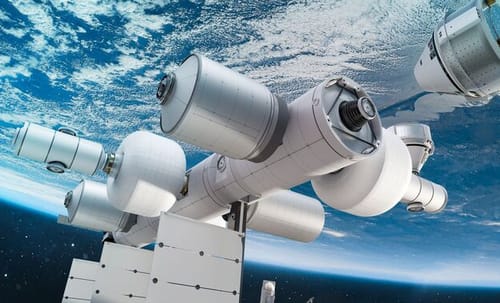 |
| Jeff Bezos plans to build a commercial space station |
Space company Jeff Bezos Blue Origin has announced plans to build its space station. The future Orbital Reef space station will begin service in the second half of this century and will provide researchers, industrial and commercial clients and international partners with places to work and stay.
Blue Origin is working with Sierra Space, a subsidiary of the Sierra Nevada Corporation, on the Tropical Reef Project.
Dream Chaser is a winged space plane designed to transport cargo to the International Space Station. It is the most famous project of Sierra Space.
Dream Chaser plans to launch cargo flights in 2022. Blue Origin said Orbital Reef has additional support as well. Including industry giant Boeing as well as Genesis Engineering Solutions and Arizona State University.
The interior space of the reef is roughly the same size as the International Space Station, can accommodate up to 10 people and contains a separate lounge and testing area.
According to Jeff Bezos, Orbital Reef is a mixed-use commercial space complex that includes multiple outlets and terminals for access to spacecraft and units, as well as multiple facilities.
Blue Origin is proud of the fact that the space station has an open system architecture that allows all types of people and customers to use the facility.
The list of potential users also includes airline agencies, media, travel agents, entrepreneurs, investors and technology companies.
According to Blue Origin, the site has a full range of services for anyone who wants to use it. Technical assistance in transportation, room rental, robotic equipment and services.
"As a major commercial target in low Earth orbit, reefs provide the essential infrastructure needed to expand economic activity and enter new markets in space," Blue Origin wrote in a press release.
The plant will start operating in the second half of this decade
The company did not want to provide accurate information on the costs of the space station, nor did it want to reveal how much money the partners would invest in the project.
The two companies said they envisioned Boeing's new Starliner spacecraft and Sierra Space's Dream Chaser as orbital reefs that would enable the transportation of people and goods.
The plan also launches most of the Orbital Reef hardware via Blue Origin's futuristic New Glenn rocket.
NASA offers incentives to companies to build space station projects. So this year the agency announced the start of a new program called the Commercial Low Earth Orbit Development Program.
The plan is to provide funds to space companies to help develop a space station that NASA may visit one day. NASA plans to provide up to $400 million under the Space Act Agreement to fund initial research at these space stations.
The commercial near-earth orbit development program is just one step in NASA's long-term plan to phase out the International Space Station and turn it into a commercial space station.
The International Space Station currently plans to operate until 2024. NASA hopes to extend the program until 2028.
But the International Space Station (ISS) costs NASA $4 billion in operating costs each year. Thus, NASA hopes to get rid of this mission and focus on manned spaceflight over distant space targets.
